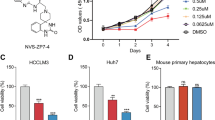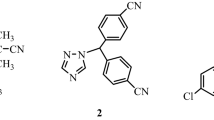Abstract
Butorphanol, a synthetic opioid, exerts analgesic and anti-inflammatory effects against pathogenic diseases. Butorphanol repressed malignant behaviors of tumor cells. In this study, the role of butorphanol in hepatocellular carcinoma was evaluated. Firstly, hepatocellular carcinoma cells were treated with butorphanol. The results showed that butorphanol decreased cell viability of hepatocellular carcinoma cells. Cell proliferation and metastasis of hepatocellular carcinoma cells were inhibited by butorphanol. Secondly, butorphanol suppressed angiogenesis, and reduced phosphorylation levels of p38 and JNK in hepatocellular carcinoma cells. Thirdly, butorphanol reduced in vivo tumor growth of hepatocellular carcinoma in nude mice. Butorphanol reduced tumor micro-vascular density (MVD) and repressed lung metastasis. In conclusion, butorphanol exerted anti-angiogenic and anti-metastatic effects on hepatocellular carcinoma and induced inactivation of MAPKs signaling.
This is a preview of subscription content, access via your institution
Access options
Subscribe to this journal
Receive 12 print issues and online access
$259.00 per year
only $21.58 per issue
Buy this article
- Purchase on Springer Link
- Instant access to full article PDF
Prices may be subject to local taxes which are calculated during checkout






Similar content being viewed by others
Data availability
All data generated or analyzed during this study are included in this published article.
References
Alqahtani A, Khan Z, Alloghbi A, Said Ahmed TS, Ashraf M and Hammouda DM. Hepatocellular carcinoma: molecular mechanisms and targeted therapies. Medicina. 2019;55:526.
Ren Z, Ma X, Duan Z and Chen X. Diagnosis, therapy, and prognosis for hepatocellular carcinoma. Anal Cell Pathol. 2020;2020:8157406.
Moawad AW, Szklaruk J, Lall C, Blair KJ, Kaseb AO, Kamath A, Rohren SA and Elsayes KM. Angiogenesis in hepatocellular carcinoma; pathophysiology, targeted therapy, and role of imaging. J Hepatocell Carcinoma. 2020;7:77–89.
Yuki K. The role of general anesthetic drug selection in cancer outcome. Biomed Res Int. 2021;2021:2563093-.
He G-N, Bao N-R, Wang S, Xi M, Zhang T-H and Chen F-S. Ketamine induces ferroptosis of liver cancer cells by targeting lncRNA PVT1/miR-214-3p/GPX4. Drug Des Devel Ther. 2021;15:3965–78.
Li C, Fu Q, Cai J, Mei H and Shangguan W. Effects of propofol on the proliferation and migration of liver cancer cells. Exp Ther Med. 2021;22:733.
Zhu R-Y, Xiang S-Q and Chen D-R. Combined lumbar muscle block and perioperative comprehensive patient-controlled intravenous analgesia with butorphanol in gynecological endoscopic surgery. World J Clin Cases. 2021;9:10540–8.
Maeda K, Nomura H, Hotta D, Matsui T, Iwai S and Okano S. Analgesic effect of continuous rate infusion of butorphanol in unilateral total resection of mammary tumor in dogs. Arch Vet Sci Med. 2020;3:22–30.
Lin L, Liu S, Chen Z and Lin S. Effect of ketamine combined with butorphanol on emergence agitation of postoperative patients with gastric cancer. Ther Clin Risk Manag. 2016;12:713–7.
Wang B, Li Y, Shen Y, Xu Y and Zhang C. Butorphanol inhibits the malignant biological behaviors of ovarian cancer cells via down-regulating the expression of TMEFF1. Onco Targets Ther. 2020;13:10973–81.
Wen J, Zhang T, Shan Z-M, Qi M-Y, Xiu H-H, Liu L, Wu SZ, Jia Z and Xu KQ. Butorphanol, a synthetic opioid, sensitizes ABCB1-mediated multidrug resistance via inhibition of the efflux function of ABCB1 in leukemia cells. Oncol Rep. 2015;34:755–62.
Marouda C, Anagnostou T, Savvas I, Papazoglou L and Psalla D. The effect of opioid administration on cytologic and histopathologic diagnosis of canine cutaneous mast cell tumors treated by surgical excision. Vet Sci. 2022;9:202.
Zhou Q, Zhang Z, Long S, Li W, Wang B and Liang N. Opioids in cancer: the κ‑opioid receptor (review). Mol Med Rep. 2022;25:44.
Gupta K, Kshirsagar S, Chang L, Schwartz R, Law P-Y, Yee D and Hebbel RP. Morphine stimulates angiogenesis by activating proangiogenic and survival-promoting signaling and promotes breast tumor growth1. Cancer Res. 2002;62:4491–8.
Chen D, Chen Y, Yan Y, Pan J, Xing W, Li Q and Weian Z. Down-regulation of the tumour suppressor κ-opioid receptor predicts poor prognosis in hepatocellular carcinoma patients. BMC Cancer. 2017;17:553.
Chen R, Cui J, Xu C, Xue T, Guo K, Gao D, Liu Y, Ye S and Ren Z. The significance of MMP-9 over MMP-2 in HCC invasiveness and recurrence of hepatocellular carcinoma after curative resection. Ann Surgical Oncol. 2012;19:375–84.
Scheau C, Badarau IA, Costache R, Caruntu C, Mihai GL, Didilescu AC, Constantin C and Neagu M. The role of matrix metalloproteinases in the epithelial-mesenchymal transition of hepatocellular carcinoma. Anal Cell Pathol. 2019;2019:9423907.
Xie J-Y, Wei J-X, Lv L-H, Han Q-F, Yang W-B, Li G-L, Wang PX, Wu SB, Duan JX, Zhuo WF, Liu PQ and Min J. Angiopoietin-2 induces angiogenesis via exosomes in human hepatocellular carcinoma. Cell Commun Signal. 2020;18:46.
Kather JN, Marx A, Reyes-Aldasoro CC, Schad LR, Zöllner FG and Weis C-A. Continuous representation of tumor microvessel density and detection of angiogenic hotspots in histological whole-slide images. Oncotarget. 2015;6:19163–76.
Chen H and Zhang L. Downregulation of FPR1 abates lipopolysaccharide-induced inflammatory injury and apoptosis by upregulating MAPK signaling pathway in murine chondrogenic ATDC5 cells. Allergol Immunopathol. 2021;49:56–62.
Lv X, Amanguli and Yang P. The role of sodium hydrosulfide in the proliferation and apoptosis of exogenous SB203580 pre-treated human ovarian cancer cells. EJGO. 2020;41:622–8.
Yaqin Li LZ and Jun G. Naringin attenuated acute lung injury in rat model with acute pancreatitis in pregnancy through inactivation of p38 MAPK pathway. Signa Vitae. 2020;16:189–94.
Wang S-N, Lee K-T, Tsai C-J, Chen Y-J and Yeh Y-T. Phosphorylated p38 and JNK MAPK proteins in hepatocellular carcinoma. Eur J Clin Investig. 2012;42:1295–301.
Komi Y, Sogabe Y, Ishibashi N, Sato Y, Moriwaki H, Shimokado K and Kojima S. Acyclic retinoid inhibits angiogenesis by suppressing the MAPK pathway. Lab Invest. 2010;90:52–60.
Luan G, Pan F, Bu L, Wu K, Wang A and Xu X. Butorphanol promotes macrophage phenotypic transition to inhibit inflammatory lung injury via κ receptors. Front Immunol. 2021;12:692286.
Huang Y, Li S, Chen H, Feng L, Yuan W and Han T. Butorphanol reduces the neuronal inflammatory response and apoptosis via inhibition of p38/JNK/ATF2/p53 signaling. Exp Ther Med. 2022;23:229.
Funding
This work was supported by the Joint construction project of Henan Province (Grant No. LHGJ20190425).
Author information
Authors and Affiliations
Contributions
Conceptualization, methodology, and writing—original draft were performed by PG; Formal analysis, resources, and investigation were performed by QH; Formal analysis, visualization and data curation were performed by JW; Project administration, supervision, and validation were performed by LH; Validation, supervision, and writing—review and editing were performed by XN and QZ. All authors read and approved the final manuscript.
Corresponding author
Ethics declarations
Conflict of interest
The authors declare no competing interests.
Ethical approval
Ethical approval was obtained from the Ethics Committee of the Fifth Affiliated Hospital of Zhengzhou University.
Additional information
Publisher’s note Springer Nature remains neutral with regard to jurisdictional claims in published maps and institutional affiliations.
Supplementary information
Rights and permissions
Springer Nature or its licensor holds exclusive rights to this article under a publishing agreement with the author(s) or other rightsholder(s); author self-archiving of the accepted manuscript version of this article is solely governed by the terms of such publishing agreement and applicable law.
About this article
Cite this article
Guo, P., Hu, Q., Wang, J. et al. Butorphanol inhibits angiogenesis and migration of hepatocellular carcinoma and regulates MAPK pathway. J Antibiot 75, 626–634 (2022). https://doi.org/10.1038/s41429-022-00565-z
Received:
Revised:
Accepted:
Published:
Issue Date:
DOI: https://doi.org/10.1038/s41429-022-00565-z



